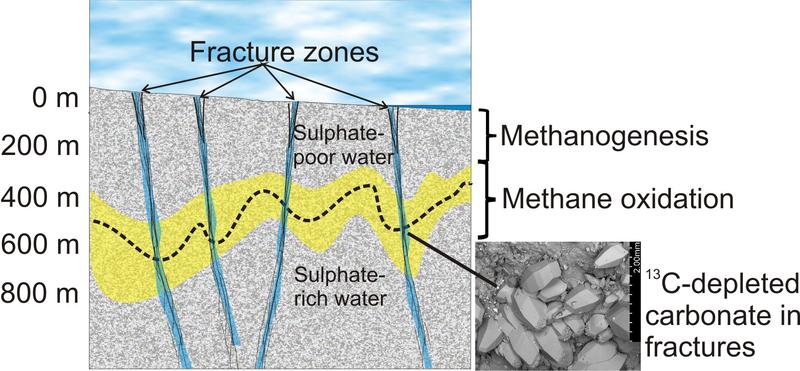

Schematic image of the preferential occurrence of methane oxidation at the transition to a deep sulphate-rich water.
The methane in the granite is consumed through microbe-mediated anaerobic oxidation, a process dominantly described from marine seabeds where it significantly mitigates the escape of methane to the atmosphere. However, the methane oxidation deep in the granite shows several intriguing differences compared to marine seabeds.
What makes the methane oxidation in the energy-poor fractured granite unique compared to other environments is the previously unseen magnitude of 13C-depletion in the carbonates precipitated during the methane oxidation.
The isotopic composition of co-genetic sulphide and specific biomarkers (e.g. fatty acids) preserved within the carbonates suggest presence of syntrophic consortia of methane oxidisers and sulphate-reducers.
Another unique feature in the fractured granite is that methane formed at shallow depth and oxidised at several hundred meters depth at the transition to a deep-seated sulphate-rich saline water.
This spatial distribution of methane and sulphate is completely opposite to what is observed during methane oxidation in near surface environments such as seabeds.
This previously unknown methane-trapping process of surficial methane at the transition to a deep sulphate-rich water can theoretically be widespread in the sparsely investigated deep terrestrial landscape. This process can thereby be of importance for the carbon cycling within the upper crust and for preventing methane to reach the atmosphere.
The results are presented in the article ”Extreme 13C-depletion of carbonates formed during oxidation of biogenic methane in fractured granite” in Nature Communications (open access).
Contact: Henrik Drake, henrik.drake@lnu.se
http://www.nature.com/ncomms/2015/150507/ncomms8020/abs/ncomms8020.html












